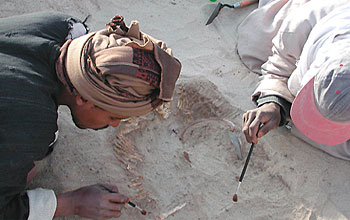|

Media Advisory 08-024
NSF Launches Special Report to Highlight Differences and Similarities Between the Worlds of Science and Indiana Jones

May 21, 2008
As audiences around the world eagerly await the opening of the fourth installment in the Indiana Jones film saga on May 22, the National Science Foundation (NSF) has launched a special report on its Web site that illustrates where the real world of archaeology diverges from the "reel" world, as well as where they infrequently intersect. While no one expects that the fictional Indiana Jones, the hero of four swashbuckling tales of adventure, to resemble real scientists, archaeologists concede that parallels do exist with their work. NSF-supported archeologists do discover "lost cities." They try to figure out what happened to "vanished civilizations" and whether what caused their collapse may have relevance to contemporary problems. They seek rare and precious artifacts that tell important stories about the past, even if those artifacts are minute snails and the scrapings of ancient teeth and not golden idols. They "deal with Native peoples," though with respect, as partners in the process of learning about the past, rather than with weapons. And certainly, as is jokingly noted in the latest Indian Jones adventure, teaching is an important part of what they do. "We focus on anthropological archaeology," says John Yellen, NSF's program director for archaeology and archometry in the Social, Behavioral & Economic Science directorate. "We're trying to understand broad principles of human behavior." The new special report features tales of the scientific work being done by NSF-funded archaeologists working as far afield as the Aleutians and Egypt, China and the deserts of Mexico or as close as Mississippi. It may be found at http://www.nsf.gov/news/special_reports/archaeology/index.jsp.
-NSF-

Media Contacts
Peter West, NSF (703) 292-7761 pwest@nsf.gov
Program Contacts
John E. Yellen, NSF (703) 292-8759 jyellen@nsf.gov
Anna M. Kerttula de Echave, NSF (703) 292-7432 akerttul@nsf.gov
Related Websites
Archaeology From Reel to Real: http://www.nsf.gov/news/special_reports/archaeology/index.jsp

The National Science Foundation (NSF) is an independent federal agency that
supports fundamental research and education across all fields of science and
engineering, with an annual budget of $6.06 billion. NSF funds reach all 50
states through grants to over 1,900 universities and institutions. Each year,
NSF receives about 45,000 competitive requests for funding, and makes over
11,500 new funding awards. NSF also awards over $400 million in
professional and service contracts yearly.
 Get News Updates by Email Get News Updates by Email
Useful NSF Web Sites:
NSF Home Page: http://www.nsf.gov
NSF News: http://www.nsf.gov/news/
For the News Media: http://www.nsf.gov/news/newsroom.jsp
Science and Engineering Statistics: http://www.nsf.gov/statistics/
Awards Searches: http://www.nsf.gov/awardsearch/
| 

